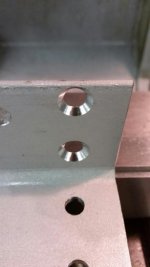Tap_or_Die
Cast Iron
- Joined
- Apr 4, 2014
- Location
- Oklahoma, USA
So we have been running stainless angle for a while now. Only in the last year we started running them on a cnc mill. The one issue we have had is the countersink just doesn't last, and I dont think its the tool, or program. The machines is just to small to run tough material (the countersink will wobble in the collet during cutting, also x and y axis show heavy loads). So I decided to decrease the pressure by trying a chamfer mill. This will be the first time using one so I'm just fishing for some tips on how to run these. My first thought is to use a helical interp and finish at the bottom.
1/8" x 2" ss angle, 5/16 through hole, need to countersink 82deg to 1/2". Tool is a accupro, 3/8, 4 flute, 82deg, TiCN coating. I know, accupro is not all that great, but ive had some good luck with them and as a test run, I wanted to try a cheaper tool before going all out.
1/8" x 2" ss angle, 5/16 through hole, need to countersink 82deg to 1/2". Tool is a accupro, 3/8, 4 flute, 82deg, TiCN coating. I know, accupro is not all that great, but ive had some good luck with them and as a test run, I wanted to try a cheaper tool before going all out.


